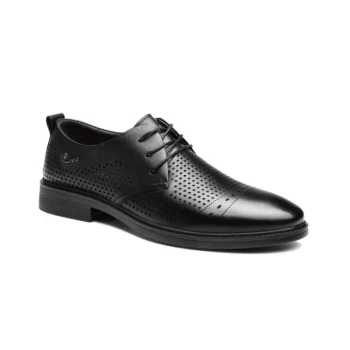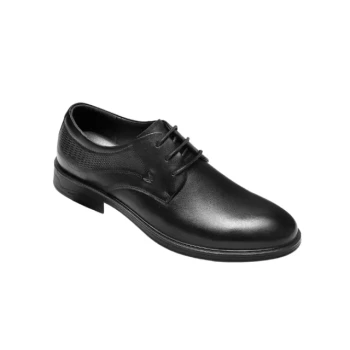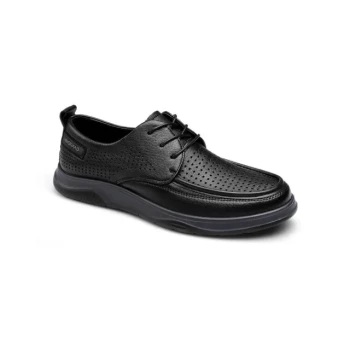At their core, comfort dress shoes differ from traditional dress shoes by re-engineering the internal structure for ergonomic support, while traditional shoes prioritize a rigid, classic silhouette above all else. Comfort dress shoes integrate features like cushioned insoles, built-in arch support, and flexible materials to allow for all-day wear without fatigue, effectively merging modern footwear technology with professional aesthetics.
The fundamental difference isn't just about softness; it's about a deliberate design philosophy. Comfort dress shoes are engineered from the inside out for the anatomy of the foot, whereas traditional dress shoes are constructed from the outside in for a specific, unchanging aesthetic.
Deconstructing "Comfort" in Modern Dress Shoes
True comfort is not accidental; it is the result of specific design choices that work together to support your foot through a long day of standing, walking, and working.
The Foundation: Advanced Insoles and Arch Support
The most significant upgrade is internal. Comfort dress shoes almost always feature cushioned, removable insoles that provide immediate shock absorption. More importantly, they offer integrated arch support, a critical feature for preventing foot strain and fatigue over many hours.
The Structure: Flexible Materials
While traditional shoes rely on stiff leather that requires a lengthy "break-in" period, comfort-focused designs use more flexible leathers, suedes, and modern composites. This allows the shoe to bend and move more naturally with your foot's motion from the very first wear.
The Sole: Shock Absorption and Stability
The outsole is another key differentiator. Traditional shoes often have thin, hard leather or wood soles with a separate heel block. Comfort dress shoes typically use thicker rubber or composite soles designed to absorb impact from hard surfaces like concrete and provide better traction and stability.
How Traditional and Casual Shoes Fall Short
Many assume that any non-formal shoe is comfortable, but this is a common misconception. Both traditional and many casual styles lack the specific engineering needed for sustained support.
The Rigidity of Formal Dress Shoes
A classic Oxford or Derby is built for structure and shape. Its sleek, compact profile is achieved with stiff materials and thin leather soles. While visually sharp, this construction offers minimal cushioning and flexibility, leading to pressure points and fatigue.
The Deception of Casual Dress Shoes
Shoes like slip-on loafers may feel comfortable initially due to softer materials. However, their underlying construction is often no different than a formal shoe, lacking proper arch support and cushioning. After hours on your feet, they create the same fatigue as their more formal counterparts.
Understanding the Trade-offs
Choosing the right shoe requires acknowledging that every design prioritizes certain characteristics. Understanding these priorities prevents disappointment.
Aesthetics vs. Ergonomics
Historically, adding comfort features meant a bulkier shoe. While modern designs have dramatically closed this gap, the most sleek and compact silhouettes are still found in traditional, rigid shoe construction. A comfort dress shoe may have a slightly wider toe box or a thicker sole to accommodate its supportive features.
Material vs. Engineered Comfort
Do not mistake expensive materials for ergonomic design. A shoe made from luxurious ostrich leather, for example, is primarily a fashion statement. While durable, its comfort depends entirely on its internal construction, not the exotic material itself.
Making the Right Choice for Your Goal
Your ideal shoe depends entirely on your primary need.
- If your primary focus is all-day wear and standing: Prioritize shoes explicitly marketed for comfort, focusing on features like arch support and cushioned, shock-absorbing soles.
- If your primary focus is the most formal, traditional aesthetic for a specific event: A classic, traditionally constructed leather-soled shoe is the appropriate choice for short-term wear.
- If your primary focus is a versatile office shoe: Look for a modern hybrid that blends a classic upper design with the flexible, supportive sole of a comfort shoe.
Ultimately, investing in a well-engineered comfort dress shoe means you no longer have to sacrifice your well-being for professional style.
Summary Table:
| Feature | Comfort Dress Shoes | Traditional Dress Shoes |
|---|---|---|
| Primary Focus | Ergonomic support & all-day wear | Rigid, classic silhouette |
| Insole & Support | Cushioned, removable insoles with arch support | Thin, flat leather insoles |
| Materials | Flexible leathers, suedes, composites | Stiff leathers requiring break-in |
| Sole | Thick rubber/composite for shock absorption | Thin leather or wood soles |
| Ideal For | Long hours of standing/walking | Short-term, formal events |
Ready to merge professional style with all-day comfort?
As a large-scale manufacturer, 3515 produces a comprehensive range of footwear for distributors, brand owners, and bulk clients. Our production capabilities encompass all types of shoes and boots, including expertly engineered comfort dress shoes that combine supportive features with professional aesthetics.
Contact us today to discuss your footwear needs and discover how we can bring value to your business.
Related Products
- Factory Direct Wholesale Leather Comfort Shoes with Dial Closure
- Wholesale Leather Business Casual Shoes with Dial Closure - Manufacturer of Comfort Dress Sneakers
- Wholesale Modern Comfort Shoes with Dial Closure for Private Label & Bulk Orders
- Custom Manufactured Air Cushion Leather Business Shoes for Wholesale
- Wholesale Comfortable Business Casual Shoes Custom Manufacturing
People Also Ask
- How does top-grain leather differ from full-grain? Choose the Right Leather for Your Products
- What should be known about genuine leather for shoes? Don't Be Misled by the Label
- What should consumers look for to avoid misleading claims about leather quality? A Guide to Identifying Genuine Quality
- What should be avoided when choosing business casual shoes? Avoid These Common Style Mistakes
- How should leather shoes be cleaned after each wear? A 60-Second Daily Ritual for Longevity



















